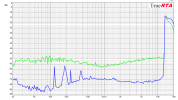bigfoamfinger
Inspired
Not sure if there's really any advantage to this approach over an IR given how deep the parameters are in AXE Edit, but wondering if anyone has tried it?
1. Shoot IRs of your Ox Box.I using an Ox Box with a Line In mod (basically the same as an Ox Stomp) with my Axe III for cab sim, and it sounds fantastic. I do plan on getting an Ox Stomp when they become readily available here on Canada.
Haha I have attempted that actually but couldn’t quite get the results I was hoping for. User error I am sure.1. Shoot IRs of your Ox Box.
2. Sell Ox Box.
3. Profit.
Since it's direct, yeah, it should be easily doable with fantastic results.Haha I have attempted that actually but couldn’t quite get the results I was hoping for. User error I am sure.
In my tests there was nothing "dynamic" about the speaker modeling. The cabinets were completely linear and exhibited no dynamic attributes. IOW, they're just IRs.Compared to the OX Stomp, the only thing Fractal doesn't have in its cab sim is room mics. But you can simulate some of that with room reverb and you have much more granular control over the mic position but less mic options.
@FractalAudio, any thoughts on these UA claims?
Going far beyond the one-dimensional captures of Impulse Response systems, only UA’s groundbreaking Dynamic Speaker Modeling convincingly emulates speaker breakup, drive, and cone cry — providing harmonics and sonic complexity indistinguishable from a perfectly studio-miked speaker cabinet.
I have seen this sort of stuff claimed by Celestion Speaker Mix for their Dynamic Speaker Response but so far when I've tried these things I have not perceived them to sound any better than good IRs.
The Fractal Amp block simulates several speaker related things already. I can understand a "cab sim only" product would include similar things in them, I'm just not buying the claims about "groundbreaking modeling" from UA. I've read some claims about UA cab sims not being IRs at all and I'm doubting that as well.
Very interesting!In my tests there was nothing "dynamic" about the speaker modeling. The cabinets were completely linear and exhibited no dynamic attributes. IOW, they're just IRs.
You can easily obtain IRs (and I have actually done so) from the Ox Box without modifying it. Simply use a solid-state power amp.
I have also obtained IRs from the Ruby and Dream pedals using the "Reference IR" feature of the Axe-Fx.
I did some fairly comprehensive tests on the Ruby and Dream pedals, FWIW. They exhibit high levels of aliasing and the frequency response is quite inaccurate compared to the real amps. The input frequency response has a significant lowpass response. They sound good though so I suppose that's ultimately what matters.
I'm doing the same thing as Satch4u3, using the Ox box for cabs. The advantage is the cabs sound great and there were times I was able to find tones that were alluding me using my regular IR's. I'm sure I could have found it eventually, but the interface on the Ox with it's very limited choice of cabs and mics is very appealing.Not sure if there's really any advantage to this approach over an IR given how deep the parameters are in AXE Edit, but wondering if anyone has tried it?
These things are obviously subjective.Very interesting!
I guess the UA pedals are liked because they are very simple to get good results since you operate it like an amp and cab sims are basically baked ready for you. I've seen some wild claims about their "betterness" on other forums so I've been tempted to find one used just to be able to compare head to head with my Axe-Fx 3 and the Strymon Iridium I have. I've tried the UA amp sims in a store and liked what I heard but at the same time didn't hear or feel this "tonal superiority" some claim they have. Same for the IK Tonex for that matter.

I assume these would shift based on how you set the Amp block AC Line Frequency setting? E.g 50 Hz = aliasing at multiples of 50 Hz.These things are obviously subjective.
Using objective tests I've found nothing inherently superior. The aliasing performance is quite poor and the frequency response is inaccurate.
I dug through my computer and found this aliasing test:View attachment 127937
The blue is the Axe-Fx III, the green is the Dream. The spikes in the Axe-Fx are power supply ripple (since we model an AC power supply). Note the peaks are at 120, 180, etc. Multiples of 60 Hz.
I did the same thing when I had a Ruby here to demo. I really liked the Silver cab setting on there.I have also obtained IRs from the Ruby and Dream pedals using the "Reference IR" feature of the Axe-Fx.
I assume these would shift based on how you set the Amp block AC Line Frequency setting? E.g 50 Hz = aliasing at multiples of 50 Hz.
Without knowing anything beyond the basics of what alłasing means, what are "good" and "bad" numbers for this? Obviously lower is better, but what is the threshold where it starts to be an audible problem, with squirrels coming out of the woodworks?


The cabinets were completely linear and exhibited no dynamic attributes. IOW, they're just IRs.
Still baffles me why they chose to "hide" the line-in
The official claim is that they model the whole cab section mathematically, which I also find hard to believe
since guitar players are mostly a techincally conservative bunch, adding a small room reverb after or inside the cab block simply doesn't sound as convenient as mixing in "room mics" with a single, always present, slider.
The Kemper cabinet portion is not dynamic either. It's also just an IR, and a short one at that (about 256 samples).This doesn't surprise me. If it could capture the nonlinear behaviors of a cab, it'd also be very close to working as a Kemper replacement....which they would have done by now if it could do that.
I assume that the Ox's compressors are actually compressing though, right?
IDK....I kinda think that the Ox Box/Stomp would be cool (due to the room mics)....if it weren't for the fact that you can find room mic IRs pretty easily...and the Ox doesn't come with cabs I really like....and AFAIK they haven't ever added any.
How does UA achieve the cry cone part if it's just an IR they're using? Do they just use some overdrive/distortion generator on top for specific frequencies?The Kemper cabinet portion is not dynamic either. It's also just an IR, and a short one at that (about 256 samples).
